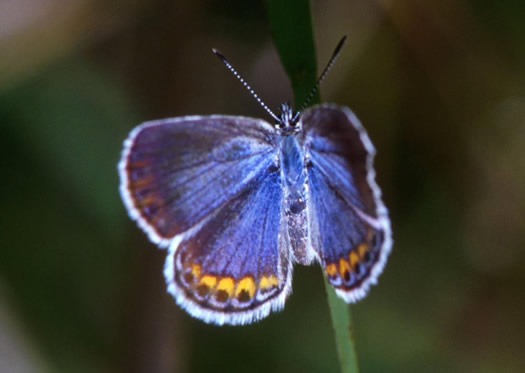The Karner Blue

Nabokov once described the a group of Karner Blues appearing like "blue snowflakes".
The first flight of Karner Blue butterflies should be appearing in their habitats around the Capital Region right about now.
The beautiful endangered butterflies hang around sandy pine barren habitats. Two such spots in the Capital Region: the Albany Pine Bush Preserve and the Wilton Wildlife Preserve. Drew was at the Wilton preserve this past week and said the butterflies were easy to spot.
Karner Blues congregate in these habitats because they're also the habitat for blue lupine. The butterflies lay their eggs on the plants.
There's some great history Capital Region history involving the Karner Blue. The common name of the butterflies is linked to a spot here -- and Vladimir Nabokov classified the butterflies. Yep, the author.
Nabokov had identified and given a scientific name (Lycaeides melissa samuelis) to the Karner Blue in 1943. But it wasn't until seven years later that he actually saw one in the wild. [NYT]
In 1950, five years before the publication of Lolita, Nabokov was a professor at Cornell. During a trip from Boston to Ithaca, he stopped in Karner, New York -- a hamlet in the Albany Pine Bush. From Brian Boyd's Vladimir Nabokov: The American Years:
On his way back to Ithaca, Nabokov had to investigate a patch of pine-scrub waste by the railroad tracks near Karner, a once a whistle-stop on the New York Central Railroad between Albany and Schenectady. In that location Lycaeides samuelis, a butterfly he had been the first to classify correctly, had been recorded ninety years ago. He had still not caught the thing himself, despite holidaying in New Hampshire four years before for that very purpose. Now at Karner, near patches of lupine in bloom, he took his first live specimens of the species. A faithful pilgrim, he would make the same stop at the same season every year for several years to come as he traveled to or from Boston.
Nabokov apparently found the butterflies all over the "absolutely marvelous patches of lupines in bloom" -- one swipe of his net reportedly captured a dozen of them. [Nabokov letter] [NYT]
The Russian author was a serious, self-taught butterfly expert. He even developed a hypothesis about the evolution of a group of blue butterflies that has since been supported by genetic research. [NYT]
In one of those weird turns of history, Karner -- the hamlet -- was named after Theodore Karner, its founder. He had plans to grow the place until it consumed much of the Pine Bush -- which would have killed off the habitat for the Karner Blue. His plans never got very far. [Kurt Johnson via Penn State]
Other people made more headway developing the Pine Bush. The Thruway plowed through it. The Albany landfill is there. And, of course, there's a mall. (There was once a little display near one of the entrances noting the Karner Blue -- that always struck us as... ironic.)
The loss of habitat -- not just here, but in other states such as Wisconsin and Michigan -- has threatened the Karner Blue and it's on a list protected by the federal Endangered Species Act. [US FWS]
In 1984, the Karner Blue lost out to the ladybug in its bid to become the official state insect, despite a campaign by school kids in Guilderland. The butterfly was clearly robbed. [NYT]
The Wilton Wildlife Preserve reportedly now has the largest population of Karner Blues in the Northeast. Roy McDonald -- the state Senator, who was once Wilton town supervisor -- told NYT in 1999 of the creation of the preserve: "If there was no butterfly we'd be doing this anyway, but the butterfly gives us the mystique." [Post-Star] [NYT]
There's a Lupine Festival there this weekend that includes walks for sighting the butterflies.
Earlier on AOA:
+ Why the Albany Pine Bush is sandy
+ On state animals, vegetables and whatnot
photo: Hollingsworth, J & K/US FWS via Wikipedia
Hi there. Comments have been closed for this item. Still have something to say? Contact us.
Comments
Very interesting. I did not know that about Nabokov.
The blue lupine in front of the Pine Bush Discovery Center this year has been just beautiful! It definitely puts my garden (which includes a few lupine plants) to shame!
... said Ellen on Jun 3, 2011 at 7:54 PM | link